Performance of Sensor Data Process Offloading on 5G-Enabled UAVs
Abstract
1. Introduction
2. UAV as UE
2.1. UAV’s Data Flows
UAV Payload Communication
2.2. Cell Uplink Capacity and 5G UE
UL Enhancements
3. Experimental Architecture and Results
3.1. System Architecture
3.2. Sensor Offloading—Stationary 5G-UAV
3.3. Autonomous UAV Mission and Sensor Offloading—Data Traffic Overload
3.4. Congestion Control
3.5. Competing Traffic from Multiple 5G-UAVs
4. Conclusions
Author Contributions
Funding
Institutional Review Board Statement
Informed Consent Statement
Data Availability Statement
Conflicts of Interest
References
- Ikeda, T.; Yasui, S.; Fujihara, M.; Ohara, K.; Ashizawa, S.; Ichikawa, A.; Okino, A.; Oomichi, T.; Fukuda, T. Wall contact by octo-rotor UAV with one DoF manipulator for bridge inspection. In Proceedings of the 2017 IEEE/RSJ International Conference on Intelligent Robots and Systems (IROS), Vancouver, BC, Canada, 24–28 September 2017; pp. 5122–5127. [Google Scholar]
- Jordan, S.; Moore, J.; Hovet, S.; Box, J.; Perry, J.; Kirsche, K.; Lewis, D.; Tse, Z.T.H. State-of-the-art technologies for UAV inspections. IET Radar Sonar Navig. 2018, 12, 151–164. [Google Scholar] [CrossRef]
- Elijah, O.; Rahman, T.A.; Yeen, H.C.; Leow, C.Y.; Sarijari, M.A.; Aris, A.; Salleh, J.; Han, C.T. Application of UAV and Low Power Wide Area Communication Technology for Monitoring of River Water Quality. In Proceedings of the 2018 2nd International Conference on Smart Sensors and Application (ICSSA), Kuching, Malaysia, 24–26 July 2018; pp. 105–110. [Google Scholar] [CrossRef]
- Zeng, Y.; Wu, Q.; Zhang, R. Accessing from the Sky: A Tutorial on UAV Communications for 5G and beyond. Proc. IEEE 2019, 107, 2327–2375. [Google Scholar] [CrossRef]
- 3gpp. 3rd Generation Partnership Project; Technical Specification Group Services and System Aspects; Enhancement for Unmanned Aerial Vehicles; (Release 17). Available online: https://portal.3gpp.org/desktopmodules/Specifications/SpecificationDetails.aspx?specificationId=3557 (accessed on 5 November 2022).
- Fotouhi, A.; Qiang, H.; Ding, M.; Hassan, M.; Giordano, L.G.; Garcia-Rodriguez, A.; Yuan, J. Survey on UAV Cellular Communications: Practical Aspects, Standardization Advancements, Regulation, and Security Challenges. IEEE Commun. Surv. Tutor. 2019, 21, 3417–3442. [Google Scholar] [CrossRef]
- Liu, B.; Zhang, W.; Chen, W.; Huang, H.; Guo, S. Online computation offloading and traffic routing for UAV swarms in edge-cloud computing. IEEE Trans. Veh. Technol. 2020, 69, 8777–8791. [Google Scholar] [CrossRef]
- Hu, F.; Deng, Y.; Zhou, H.; Jung, T.H.; Chae, C.B.; Aghvami, A.H. A vision of an XR-aided teleoperation system toward 5G/B5G. IEEE Commun. Mag. 2021, 59, 34–40. [Google Scholar] [CrossRef]
- Wu, Y.H.; Li, C.Y.; Lin, Y.B.; Wang, K.; Wu, M.S. Modeling Control Delays for Edge-enabled UAVs in Cellular Networks. IEEE Internet of Things Journal 2022, 9, 16222–16233. [Google Scholar] [CrossRef]
- Chinchali, S.; Sharma, A.; Harrison, J.; Elhafsi, A.; Kang, D.; Pergament, E.; Cidon, E.; Katti, S.; Pavone, M. Network offloading policies for cloud robotics: A learning-based approach. Auton. Robots 2021, 45, 997–1012. [Google Scholar] [CrossRef]
- Nakanoya, M.; Chinchali, S.; Anemogiannis, A.; Datta, A.; Katti, S.; Pavone, M. Co-Design of Communication and Machine Inference for Cloud Robotics. In Proceedings of the Robotics: Science and Systems, Online, 12–16 July 2021. [Google Scholar]
- Lin, L.; Liao, X.; Jin, H.; Li, P. Computation Offloading Toward Edge Computing. Proc. IEEE 2019, 107, 1584–1607. [Google Scholar] [CrossRef]
- Pakha, C.; Chowdhery, A.; Jiang, J. Reinventing video streaming for distributed vision analytics. In Proceedings of the 10th USENIX Workshop on Hot Topics in Cloud Computing (HotCloud 18), Boston, MA, USA, 9 July 2018. [Google Scholar]
- Chinchali, S.P.; Cidon, E.; Pergament, E.; Chu, T.; Katti, S. Neural networks meet physical networks: Distributed inference between edge devices and the cloud. In Proceedings of the 17th ACM Workshop on Hot Topics in Networks, New York, NY, USA, 15–16 November 2018; pp. 50–56. [Google Scholar]
- Mishra, D.; Natalizio, E. A Survey on Cellular-connected UAVs: Design Challenges, Enabling 5G/B5G Innovations, and Experimental Advancements. Comput. Netw. 2020, 182, 107451. [Google Scholar] [CrossRef]
- She, C.; Liu, C.; Quek, T.Q.; Yang, C.; Li, Y. Ultra-reliable and low-latency communications in unmanned aerial vehicle communication systems. IEEE Trans. Commun. 2019, 67, 3768–3781. [Google Scholar] [CrossRef]
- Zeng, Y.; Lyu, J.; Zhang, R. Cellular-connected UAV: Potential, challenges, and promising technologies. IEEE Wirel. Commun. 2019, 26, 120–127. [Google Scholar] [CrossRef]
- Seisa, A.S.; Satpute, S.G.; Lindqvist, B.; Nikolakopoulos, G. An Edge-Based Architecture for Offloading Model Predictive Control for UAVs. Robotics 2022, 11, 80. [Google Scholar] [CrossRef]
- Dahlman, E.; Parkvall, S.; Skold, J. 5G NR: The Next Generation Wireless Access Technology, 1st ed.; Academic Press: Cambridge, MA, USA, 2020. [Google Scholar]
- NR; User Equipment (UE) Radio Access Capabilities 3gpp. Available online: https://portal.3gpp.org/desktopmodules/Specifications/SpecificationDetails.aspx?specificationId=3193 (accessed on 22 September 2022).
- Williamson, R.; Li, R.Y.; Fleischer, W.; Rose, L.; Orlando, A.; Zhang, H.; Han, X. 5G TDD Uplink by NGMN Alliance. 2021. Available online: https://www.ngmn.org/publications/5g-tdd-uplink-white-paper.html (accessed on 10 December 2022).
- Johansson, I. Self-clocked rate adaptation for conversational video in LTE. In Proceedings of the 2014 ACM SIGCOMM Workshop on Capacity Sharing Workshop, Chicago, IL, USA, 18 August 2014; pp. 51–56. [Google Scholar]
- Willars, P.; Wittenmark, E.; Ronkainen, H; Östberg, C.; Johansson, I.; Strand, J.; Lédl, P.; Schnieders, D. Enabling Time-Critical Applications over 5G with Rate Adaptation. Available online: https://www.ericsson.com/en/reports-and-papers/white-papers/enabling-time-critical-applications-over-5g-with-rate-adaptation (accessed on 5 October 2022).
- Krzanich, B. Data is the New Oil in the Future nof Automated Driving Intel. Available online: https://newsroom.intel.com/editorials/krzanich-the-future-of-automated-driving/#gs.l6jnei (accessed on 22 December 2022).



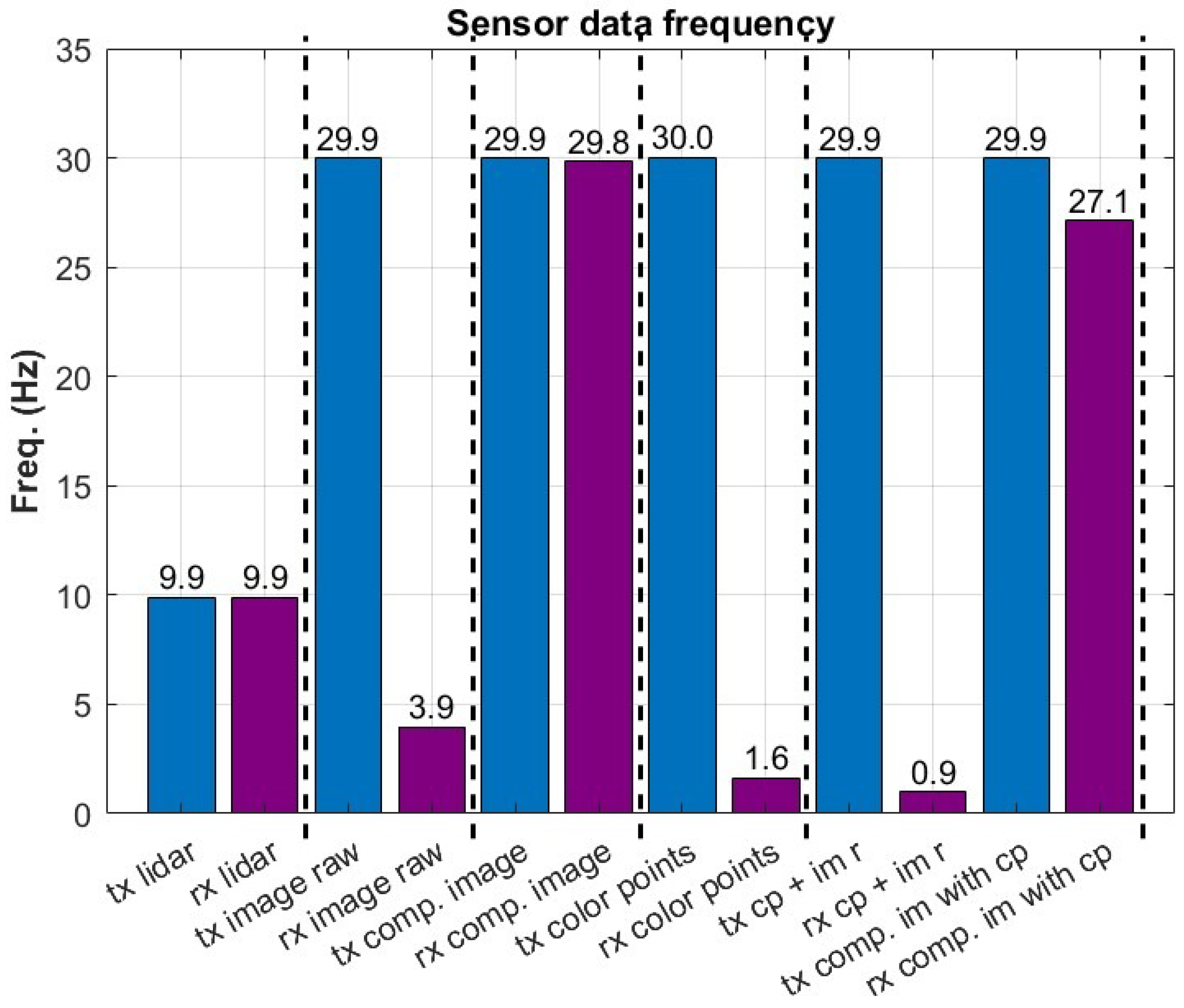
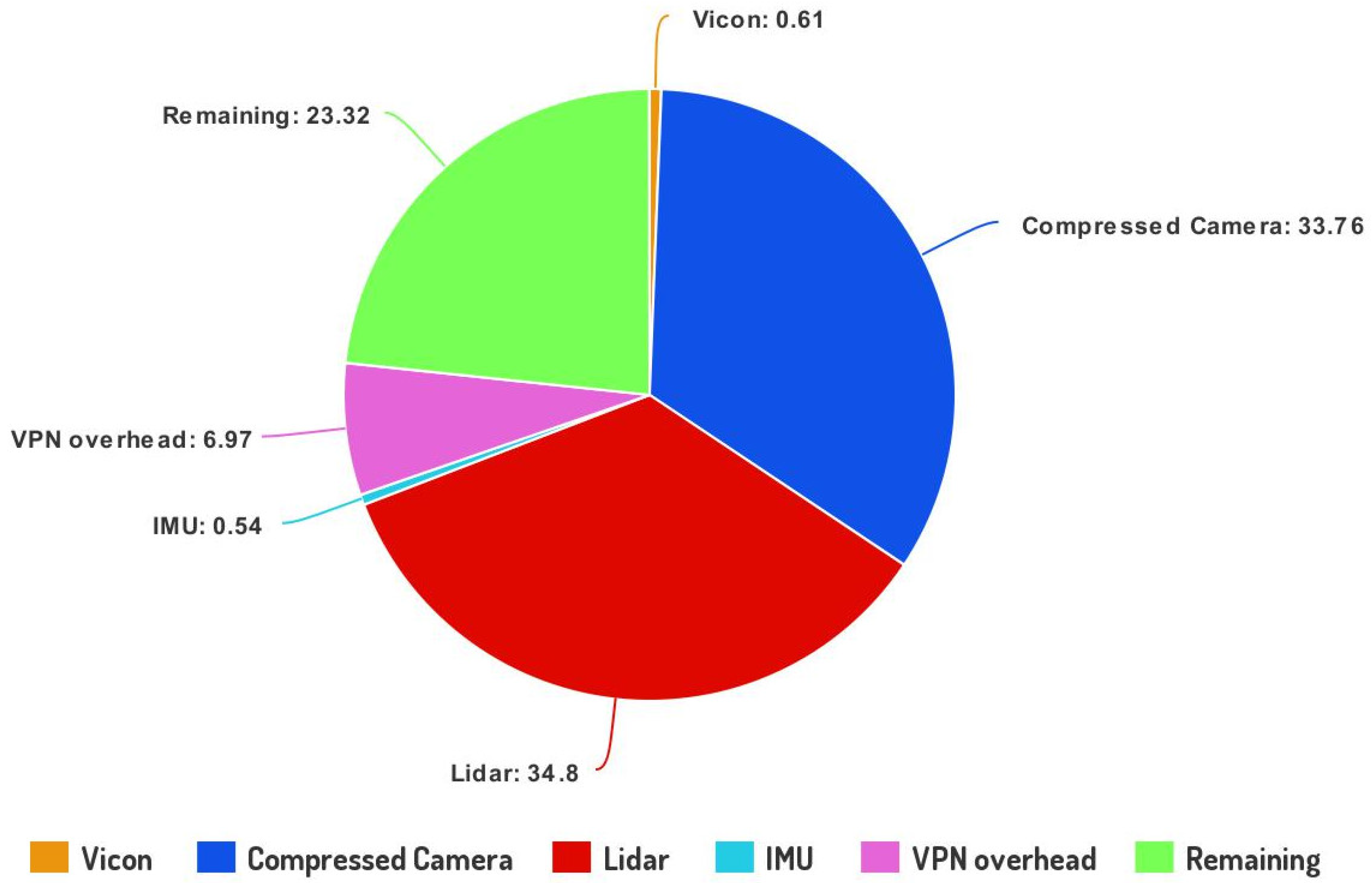


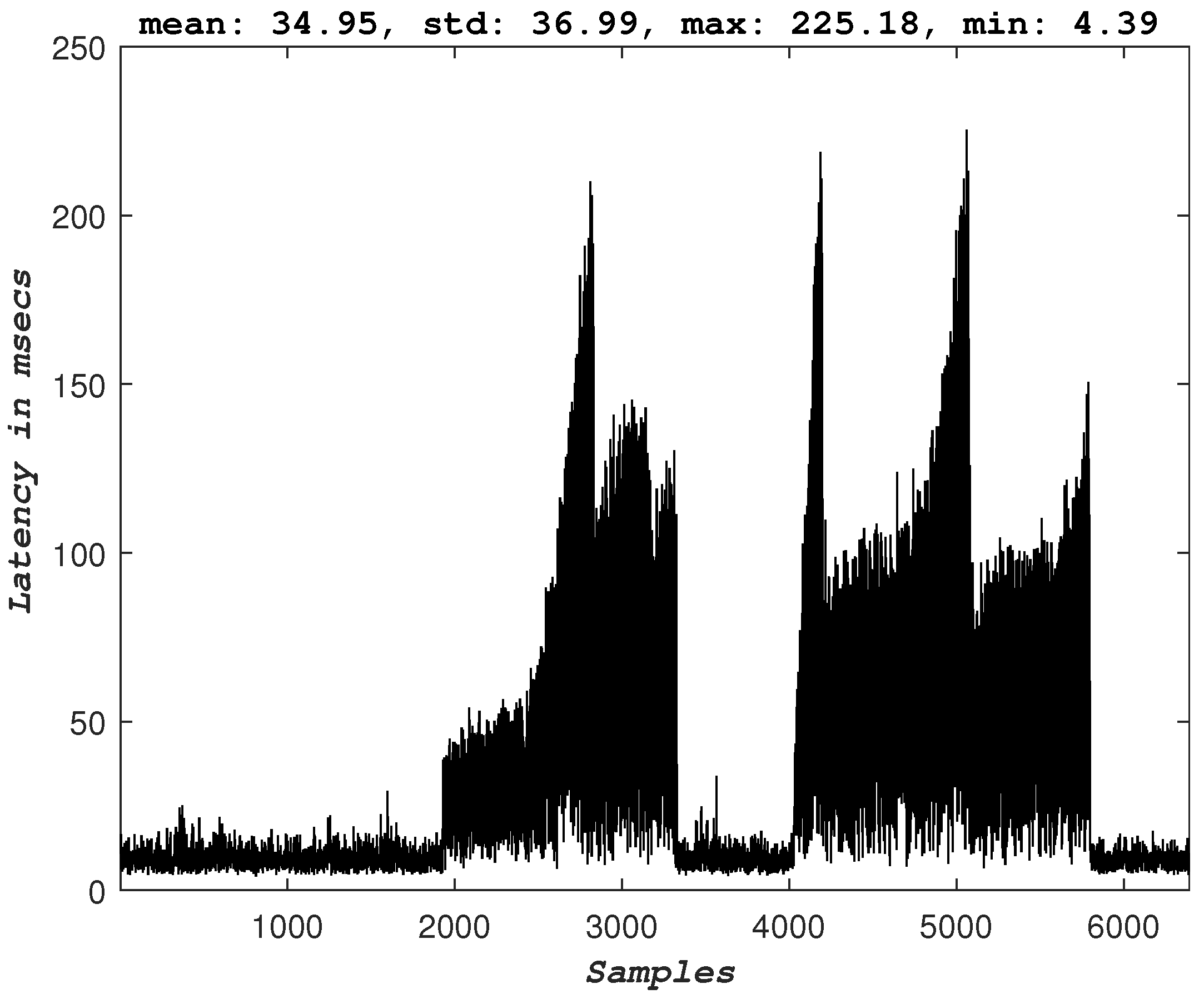
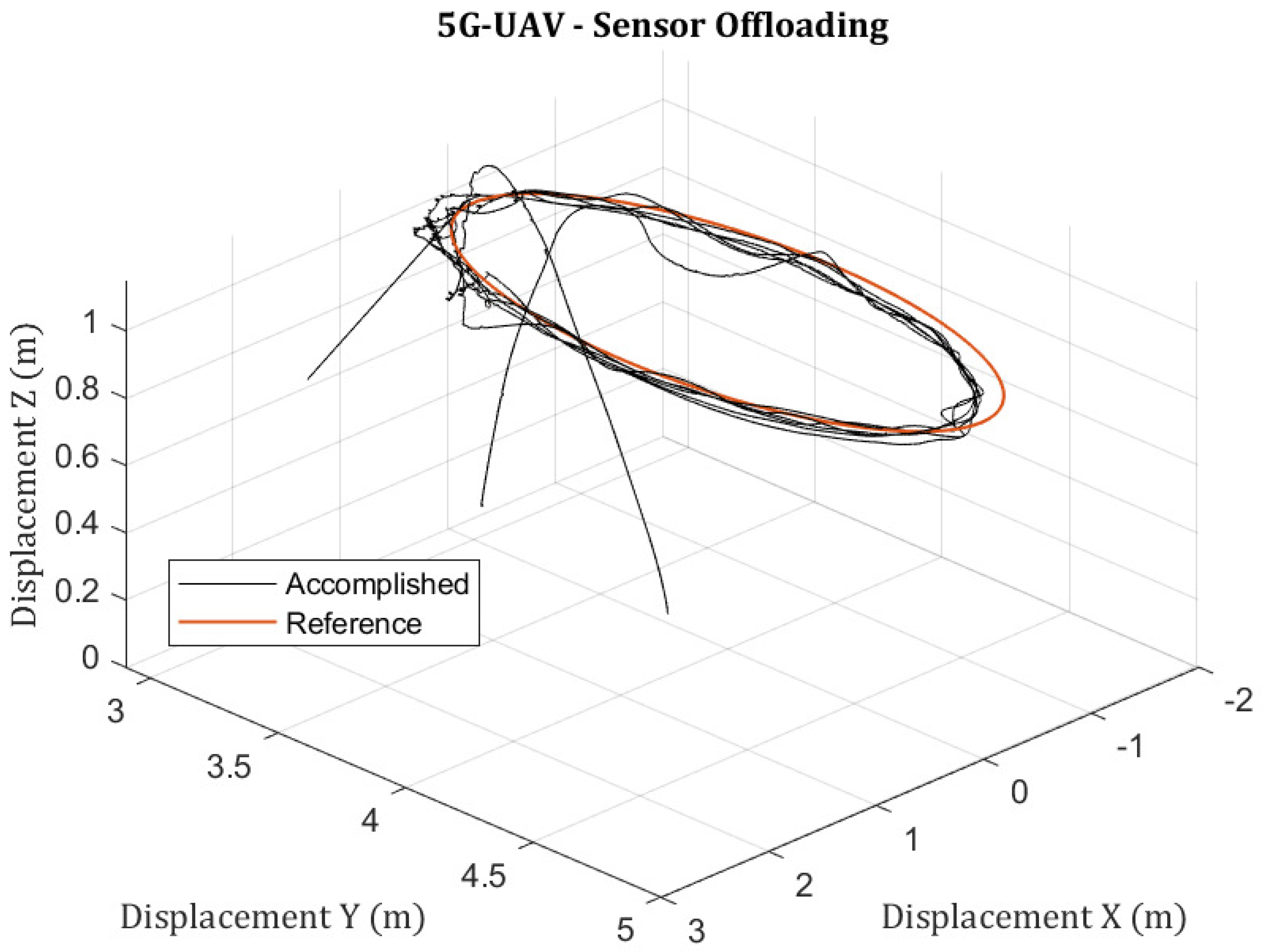
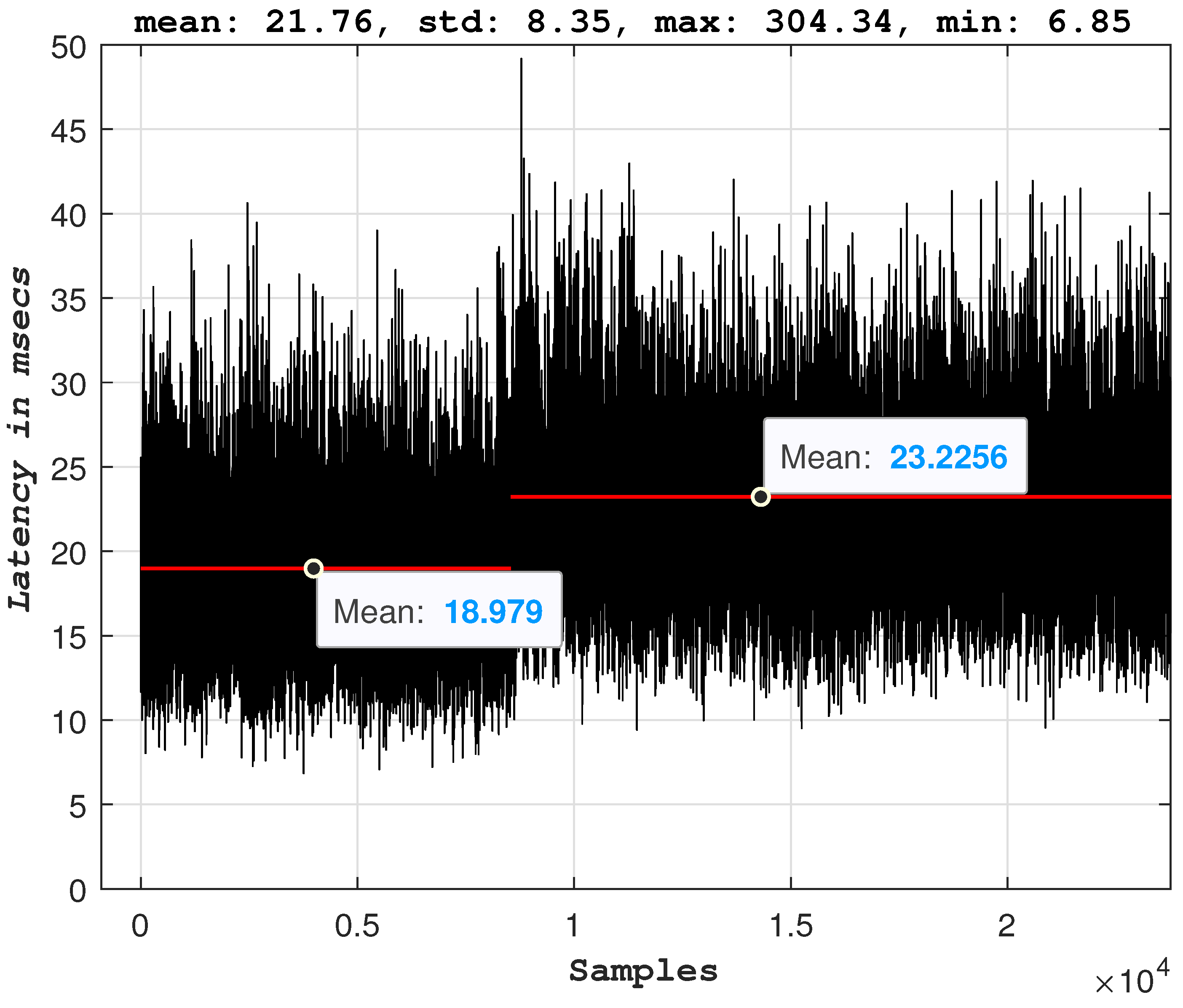
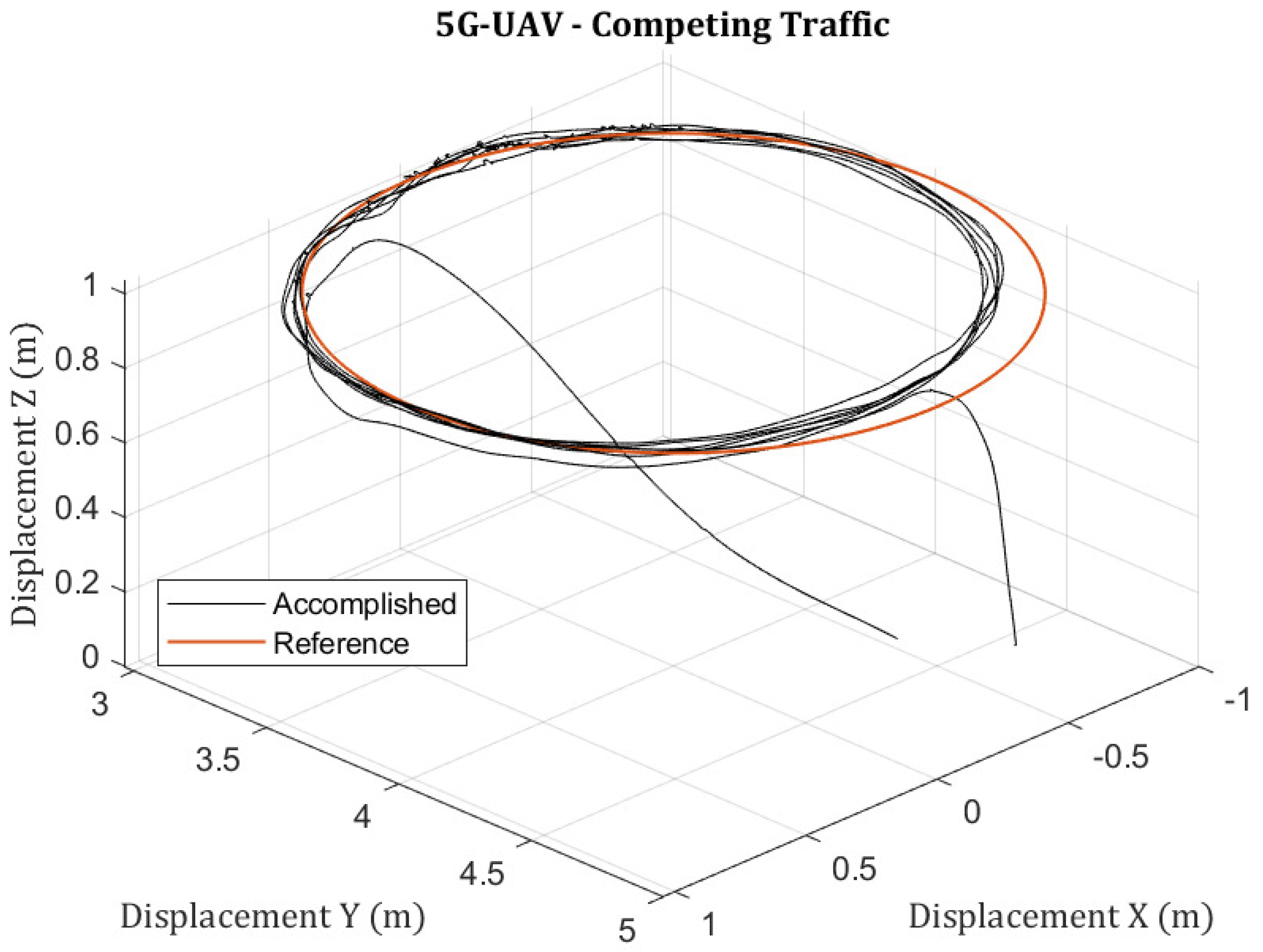
| Parameters | Value |
|---|---|
| Mode | TDD |
| J | 1 |
| 1 in UL, 4 in DL | |
| Q | 6 (64 QAM) |
| f | 1 |
| 100 MHz | |
| 0.08 (3GPP 38.306) | |
| DL/UL Ratio | 4:1 |
| FR1/FR2 | FR1 |
| Downlink | 1402 Mbps |
| Uplink | 94 Mbps |
| Sensor | Type of Sensor Data | Data Rate | Frequency | Offloading Task |
|---|---|---|---|---|
| Real Sense | Raw Image | ∼667 Mbps | ∼30 Hz | object detection, perception algorithms, collision avoidance, optimization algorithms, … |
| Real Sense | Compressed Image | ∼30 Mbps | ∼30 Hz | object detection, perception algorithms, collision avoidance, optimization algorithms, … |
| Real Sense | Depth Point Cloud (RGB) | ∼1600 Mbps | ∼30 Hz | object detection, perception algorithms, mapping, collision avoidance, optimization algorithms, … |
| Velodyne | Raw Point Cloud | ∼46.5 Mbps | ∼10 Hz | mapping, collision avoidance, enhanced teleoperation, … |
| Real Sense + IMU | State Vector | ∼20 Kbps | ∼30 Hz | Remote controllers, centralized optimization problems, path planning, localization, … |
| Velodyne + IMU | State Vector | ∼20 Kbps | ∼10 Hz | Remote controllers, centralized optimization problems, path planning, localization, … |
Disclaimer/Publisher’s Note: The statements, opinions and data contained in all publications are solely those of the individual author(s) and contributor(s) and not of MDPI and/or the editor(s). MDPI and/or the editor(s) disclaim responsibility for any injury to people or property resulting from any ideas, methods, instructions or products referred to in the content. |
© 2023 by the authors. Licensee MDPI, Basel, Switzerland. This article is an open access article distributed under the terms and conditions of the Creative Commons Attribution (CC BY) license (https://creativecommons.org/licenses/by/4.0/).
Share and Cite
Damigos, G.; Lindgren, T.; Sandberg, S.; Nikolakopoulos, G. Performance of Sensor Data Process Offloading on 5G-Enabled UAVs. Sensors 2023, 23, 864. https://doi.org/10.3390/s23020864
Damigos G, Lindgren T, Sandberg S, Nikolakopoulos G. Performance of Sensor Data Process Offloading on 5G-Enabled UAVs. Sensors. 2023; 23(2):864. https://doi.org/10.3390/s23020864
Chicago/Turabian StyleDamigos, Gerasimos, Tore Lindgren, Sara Sandberg, and George Nikolakopoulos. 2023. "Performance of Sensor Data Process Offloading on 5G-Enabled UAVs" Sensors 23, no. 2: 864. https://doi.org/10.3390/s23020864
APA StyleDamigos, G., Lindgren, T., Sandberg, S., & Nikolakopoulos, G. (2023). Performance of Sensor Data Process Offloading on 5G-Enabled UAVs. Sensors, 23(2), 864. https://doi.org/10.3390/s23020864







